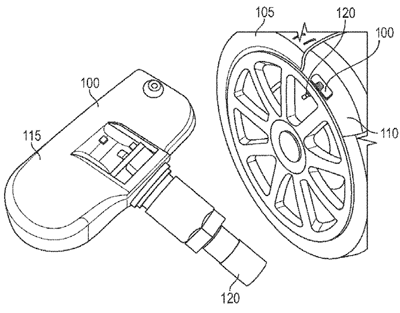Patents for January
Patent as compiled by the editors of RW for January 2024.
Tire pressure monitoring system (TPMS) sensor with easily removable and replaceable battery
U.S. patent: 11,738,607
Issued: August 29, 2023
Inventor: Christian Haesemeyer
Assigned: Astra Sensor Technologies
Key statement: A TPMS sensor with an externally replaceable battery is disclosed. The valve stem
facilitates battery replacement with a valve stem core designed to removably secure a battery within the
valve stem and a sensor configured with an electrical connection designed to connect the sensor to
power from the battery. The valve stem has an interior cavity configured to retain the valve stem core.
The battery may be at least partially retained within the valve stem. The sensor may be configured in a
sensor body connected to an end of the valve stem distal from the valve stem core. The electrical
connection may comprise a spring-loaded terminal configured to connect or disconnect the sensor and
battery as the battery is inserted or removed from the valve stem through a valve stem end proximal to
the valve stem core, permitting battery replacement without removing or deflating a tire configured with
the sensor.
Tire patch detection
U.S. patent: 11,738,610
Issued: August 29, 2023
Inventor: Jeremie Chabloz
Assigned: Melexis Technologies SA
Key statement: A detection system for extracting information from a sensor module in a rolling wheel
comprises: a sensor module which comprises a sensor adapted for sensing a physical property of the tire
when mounted in a tire of the wheel or on an inner surface of a tire of the wheel; an acquisition module
adapted for sampling a signal from the sensor module, thus obtaining a sequence of data samples; a
correlation module adapted for cross-correlating a signed reference sequence with the sequence of data
samples thus obtaining a correlation sequence; an extraction module adapted for identifying at least one
perturbation in the correlation sequence, wherein the perturbation is induced when a part of the tire
where the sensor is mounted hits the ground thereby forming the tire patch.
Glycerol-silicone elastomers as active matrices with controllable release profiles
U.S. patent: 11,739,194
Issued: August 29, 2023
Inventors: Anne Ladegaard Skov, Michael Adrian Brook and Piotr Stanislaw Mazurek
Assigned: Danmarks Tekniske Universitet
Key statement: Herein is disclosed an elastomeric silicone composition comprising at least a first and a
second glycerol phase which are distinct from each other and a method of making the same. The
elastomeric compositions are special therein that zero-order active substance release can reversibly be
obtained by modifying the glycerol content of the silicone composition.
Sulfur-crosslinkable rubber mixture vulcanizate and vehicle tire
U.S. patent: 11,739,198
Issued: August 29, 2023
Inventors: Julia Schöffel, Norbert Müller, Carla Recker and Kirsten Schwekendiek
Assigned: Continental Reifen Deutschland GmbH
Key statement: The invention relates to a sulfur-crosslinkable rubber mixture, a vulcanizate and a vehicle
tire. The sulfur-crosslinkable rubber mixture contains at least the following constituents:
at least one diene rubber and at least one silica and at least one silane having the general empirical formula
[(R1)oSi—(R3—)pX—(R4—)p]mSn(R2)2-m, I) where X is a radical comprising at least one polar group selected from urethane, amide, ester, amine,
thiourea, thioamide, O-organyl thiocarbamate, S-organyl thiocarbamate, amidine, guanidine, piperidine,
maleic anhydride, sulfonamide, carbonate, imidazoline, thiazolidine, thiazolidinone, pyrrolidine, pyrazole,
benzimidazole, indole, purine, thiazine, sulfonate and phosphonate groups.
Thermoplastic elastomer composition
U.S. patent: 11,746,221
Issued: September 5, 2023
Inventors: Masato Kobayashi, Ryoji Usui, Yuki Sato and Osamu Kose
Assigned: Eneos Materials
Key statement: Provided is a thermoplastic elastomer composition obtained by melt-kneading (A) an
ethylene/α-olefin/non-conjugated polyene copolymer rubber that is a copolymer of ethylene, an α-olefin
having 3 to 20 carbon atoms and a non-conjugated polyene, (B) a polyolefin resin and (C) a mineral
oilbased softening agent in the presence of (D) a crosslinking agent, at least part of the ethylene/αolefin/non-conjugated polyene copolymer rubber (A) being crosslinked, the thermoplastic elastomer
composition having a seaisland structure in which the ethylene/ α-olefin/non-conjugated polyene
copolymer rubber (A) is dispersed as a dispersed phase (island phase) in a continuous phase (sea phase)
of the polyolefin resin (B) and when a cross-section of the composition is observed with an atomic force
microscope (AFM), a ratio of (b) a local elastic modulus of the continuous phase to (a) a local elastic
modulus of the dispersed phase being from 10 to 30.
Method for preparing topological elastomers with highly branched structures, low modulus and high
elasticity
U.S. patent: 11,746,194
Issued: September 5, 2023
Inventors: Tao Xie, Ning Zheng and Xiaona Xu
Assigned: Zhejiang University
Key statement: A fabrication method and application of topological elastomers with highly branched
structures, low modulus and high elasticity. The topological elastomers comprise dendritic
macromolecules. The fabrication method includes direct crosslinking, post-crosslinking, grafting and
copolymerization. The performance of the elastomer can be easily tuned via changing the topology of the
polymer network. The breakthrough of this invention lies in that these topological elastomers with highly
branched structures are having low modulus and high elasticity, which would expand its application in
the field of elastomer. Notably, the variety of topological elastomers, the versatility of curing chemistries,
the availability of a wide variety of monomers and the various polymerization methods are enabling the
fabrication of topological elastomers with feasibility and efficiency.

